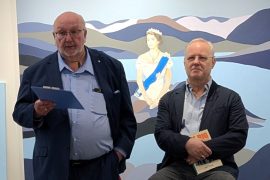Hard to believe it has been almost a year since the devastating tsunami overwhelmed the north shores of Japan. Dr. David Suzuki visited the region in December and his report back airs tonight on The Nature of Things’ “Journey to the Disaster Zone: Japan 3/11” (CBC, 8 p.m.).
I screened an unmixed early cut of the special last week and, in a phone interview, told Suzuki how, despite the lack of narration and other elements, a great sense of shock and awe was still conveyed. In an age when Flipcams and iPhones can capture and transmit video in an instant, images of actual earthquakes and tsunami’s are making people all around the world instant eye witnesses.
Suzuki says he was up early the morning of March 11, 2011, and happened to turn on CNN. “I couldn’t believe it,” he says. “Those images were pouring out live of the tsunami rolling over the land. Cars and trucks were being swept away, it was all happening at a rate of about a block a second.”
An earthquake off the northern seaboard of Japan sent tsunami waves 20 meters high sweeping toward the nation. Townsfolk who had experienced 6-meter waves just one year earlier, felt secure in their homes, scrambling to upper floors. Many drowned when waved went crashing way over their roofs.
Teachers at one school, judging that nearby cliffs were too hard to navigate, led 70 children to a large bridge spanning a river in hopes of avoiding the flood. It wasn’t high enough, and all those children and teachers perished.
There are other happier if harrowing tales of rescue and survival in tonight’s hour. You could tell Suzuki was deeply moved by what had to have been a touching and personal experience.
While reports back at the time suggested Japan acted with great speed to repair roads and bridges, Suzuki says he still saw huge piles of debris in the cities he visited. “There was no building going on anywhere except temporary housing,” he says, noting that half a million people needed housing after the disaster.
What Suzuki also didn’t see or find evidence of in the wake of the tsunami was looting. “Contrast this with New Orleans after Katrina or even
For the Japanese, says Suzuki, it is “inconceivable to pick up a rock or break a window to get supplies–it’s just not in their culture.”
That stoicism and composure serves them well in a crisis but it can also be seen as weakness, he suggests. People should be “shouting and screaming what the heck is going on, you guys aren’t telling us the truth about radiation from [damaged nuclear plants].”
Suzuki did come away with the hope that Japan, a rich, industrialized nation, may now look seriously at alternative sources of energy and back away from nuclear generators. He points out that hundreds of natural hot springs exist in the region–so why build nuclear generators which basically are used to boil water to create steam to drive turbines? The earth itself provides an alternative geo-thermal fuel answer, he suggests.
One problem is that many of these hot springs are considered sacred. Even in the U.S., he imagines, people would flip out of folks started “buggering around” with Old Faithful. Still, Suzuki hopes compromises are made and a selective approach could see some hot spring spring into alternative energy sources.
He points out that only four of the 56 nuclear plants in Japan have re-opened since the disaster. When he traveled to Tokyo, he expected to find the city half in darkness, but there was very little evidence that the plants were still shut down. Tokyo has managed to reduce energy consumption 25 percent. “All this bullshit about we need to build more and more plants for more and more energy,” Suzuki says. Doesn’t the Japanese experience suggest we can live without many of these nuclear facilities?
I mentioned to Suzuki how it sometimes unnerves me that the Brice Nuclear generating station is just 40 minutes down the shore from what I’ve always called cottage country. Thar sucker has been shut down a few times without an earthquake. I always find it a bit ironic that I drive past 150-odd windmills just north of Shelburne, Ont., on the way to the cottage and find it so puzzling why these turbines, powered by wind, are so often under attack.
Suzuki says some people are just afraid of anything new. He acknowledges they kill birds and bats. “We have to be careful where we build them,” he says. “If you really care about birds, we ought to knock down every high rise building, eliminate all cars and every cat. Cats, buildings and cars kill 90 percent of the birds and bats.”
Suzuki says he’s looking forward to the new, electric Leaf, a hybrid vehicle that will sell for around $44,000. Toyota lent him one recently and he gives it a thumbs up for performance, noting it has a 150k range before recharging. If the Leafs ever make the playoffs, they could sell a few Leafs in Ontario, I suggest. “The price of gas should be enough incentive,” says Suzuki. I hear that.

Prev Post






1 Comment
Imagine driving along in my wind-hybrid design.
http://classicquarters.blogspot.com/2008/06/big-green-car-recharged-by-wind.html